A Novel Method of Spatiotemporal Dynamic Geo-Visualization of Criminal Data, Applied to Command and Control Centers for Public Safety
Abstract
1. Introduction
2. Works Related to Criminal Activity Visualization Methods
3. Command and Control Systems (C2S) and Command and Control Information Systems (C2IS)
4. A Novel Method to Geo-Visualize Spatiotemporal Data Dynamically
4.1. Development of the Method of Spatiotemporal Dynamic Geo-Visualization of Data
4.1.1. Information and Sources
4.1.2. Stages of the Graphic Visualization Process
- The first stage consists of the collection and conditioning data to be used from SECAD and RNMC database. These databases are hosted within the C2IS and information reaches them through military-grade critical real-time communication channels arranged for this by the PONAL. This conditioning involves a process of Data Cleaning and Data Wrangling. In this case, it basically refers to the need to filter information that should not be considered a criminal incident (e.g., calls to wrong number), adaptation of geographic coordinates and timestamps, as well as organization by date. This process can be done automatically to use data in real-time.
- Those data that do not correspond to the target area or that have out-of-normal values (outliers), which may have been inserted in the database by mistake, must be deleted. However, in this process it should be borne in mind that outliers are filtered by geographical coordinates. Therefore, it is important to filter data according to metropolitan or departmental area covered by the PONAL, as appropriate, as well as to take into account the 123 emergency cases redirected to SECAD. Here, a reverse geolocation utility is generated to add it to the information in the dataset, see Section “Geocoding on the Geo-visualizer” At this point, the dataset with the data is available, and its structure corresponds to each criminal incident with its geographical coordinates, street address; and appropriate timestamp to be handled by programming language used.
- Since the observation area is limited to specific geographical coordinates of latitude and longitude and these data are ready to be used, a system of two superimposed grids delimited by the geographical coordinates of the target area is created. In this case, it is the city of Santiago de Cali and its respective areas under the police jurisdiction. The first grid (pink) is limited to the observation area and the second grid (gray) has the same size as the first one, but it moves in longitude and latitude so that the vertices of each frame of the second grid coincide with the centers of each frame of the first grid. Then, the overlapping grids create frames corresponding to 25% of the original size, Figure 3a. This coordinates system should be placed as a layer on the geographical map of the observation area, on the Geographic Information System (GIS), in which this geo-visualization method will be used as shown in Figure 3b. In other words, the method described in this article constitutes a geo-visualization tool that act like a Plug-in that can be adapted to any GIS through the API (Application Programming Interface), specific to each GIS.Latitude and longitude grid system was created in such a way that each time one or more criminal activity events are detected in one place; they are represented on the grid system with separate references to each of two grids. Then, data are represented using a smoothing method that overlaps the graphics in this density map. This is intended to facilitate observation of crime displacement and concentration, which could not be done with a single grid and that is the reason for the use of a double grid system. Figure 3a.For the specific case of spherical coordinates on the globe, the grids created had 100 frames on the latitudinal axis (approximately 358.65 m each) and 60 frames on the longitudinal axis; approximately 453.06 m each at north latitude, and approximately 453.21 m at south latitude. Notwithstanding this, it is important to emphasize that those values were selected for this case because, as specified above, the quadrants can be of different sizes, depending on the population density of the area. Hence, the resulting division of the land into 100 parts on the latitudinal axis and 60 parts on the longitudinal axis, along with the graphic smoothing technique used, represents the average extension of the quadrants in Colombia. Therefore, this approach is very useful for this case, as shown in Figure 3b. All these values can be adjusted to the follow-up needs of any geographic territory required.
- At this stage of process it is already possible to start observing information that the data could offer through this geo-visualization method. As a test of its initial operation, for Figure 4, three different data samples were taken and represented on the system created in the previous stages. Here, each criminal incident is represented by a color point with the same level of transparency, which enables the concentrations of criminal incidents to be observed in the sub-areas within the observation area. In the sub-areas where the points are more transparent, there is a lower concentration of criminal incidents, and a greater concentration of criminal incidents in the sub-areas where the points have more color concentration. This geo-visualization could be done with any data distribution required, e.g., data of one day, one week, three months, some hours, etc.
4.1.3. Construction of the Spatiotemporal Dynamic Geo-visualizer
- Two parameters must be defined: First, the temporary sliding windows (time period during which cases will be represented in each frame); and second, the time frame to slide the window, (how often the screen will be refreshed or the timestamp in which the next frame will be represented in the animation), this latter will be referred as Δt.
- In this case, there were 30-min temporary sliding windows, i.e., the cases that occurred over the last 30 min will be represented in each frame or animation frame. However, each frame will refresh each 20 min. In other words, the spatiotemporal dynamic geo-visualizer shows the cases that happened during the 30-min sliding windows, in frames that refresh every 20 min (Δt).
- According to the example, this implies that in each frame there will be a 10-min overlap. In consequence, from the second frame, the cases that occurred in the last 10 min will be repeated in the next frame. However, if the value of the temporary sliding window is 40 min and the Δt value is 20 min, for example, the overlap would now be 20 min and so on. This is intended to provide continuity and ease for the analysis of the target areas when counting events by area and observing the displacement of criminal activity (Figure 5).
- It is important to clarify that these two parameters have been specified in this way for the purpose of helping police commanders to understand the global spatiotemporal behavior of crime in the city, according with the amount of data observed. Therefore, these parameters were randomly selected at the beginning, and then adjusted by trial and error, within the geo-visualization, to find those that served the purpose of the analyst. For this reason, it can be concluded that these parameters can also be adjusted according to the requirements of the person making the observation in both, temporary sliding windows and Δt, as well as in the quantity of data (by days, months, etc.). It is also possible to use parameters that do not generate overlaps.
- Once defined the initial temporary sliding windows and Δt, the events are represented on the grids by frame or window every Δt. Then, it is possible to count the events that happened on each geographical sub-area (grid frames). To do so, a color scale has been defined; the light colors indicate low criminal activity and dark colors indicate high activity. This facilitates the interpretation of data, since transparency or absence of color represents that no event has happened, and darker colors represent a large concentration of events. A color scale can be adjusted as required by the user (Figure 6).
- The color of the frame in that sub-area at a certain moment indicates a number of incidents. For example, according to the color bar, it could be said that there were about 5 criminal incidents in that green area during that window of time. This allows the analyst to count cases by zone, time slot and hour, and also to analyze the pattern of displacement of these events, Figure 6.
- This process is repeated for each window, generating dynamism in the representation. Therefore, variation in the occurrence of criminal events can be observed using this method, since it allows to see the variations and patterns for each geographical sub-area (grid frame), Figure 6.
Geocoding on the Geo-Visualizer
5. Results and Discussion
6. Conclusions
Author Contributions
Funding
Acknowledgments
Conflicts of Interest
References
- Lacinák, M.; Ristvej, J. Smart City, Safety and Security. Procedia Eng. 2017, 192, 522–527. [Google Scholar] [CrossRef]
- Neumann, M.; Elsenbroich, C. Introduction: The societal dimensions of organized crime. Trends Organ. Crime 2016, 20, 1–15. [Google Scholar] [CrossRef]
- Yadav, S.; Timbadia, M.; Yadav, A.; Vishwakarma, R.; Yadav, N. Crime pattern detection, analysis & prediction. In Proceedings of the 2017 International conference of Electronics, Communication and Aerospace Technology (ICECA), Coimbatore, India, 20–22 April 2017; pp. 225–230. [Google Scholar]
- Yu, C.-H.; Ward, M.W.; Morabito, M.; Ding, W. Crime Forecasting Using Data Mining Techniques. In Proceedings of the 2011 IEEE 11th International Conference on Data Mining Workshops, Vancouver, BC, Canada, 11 December 2011; pp. 779–786. [Google Scholar]
- Phillips, P.; Lee, I. Mining co-distribution patterns for large crime datasets. Expert Syst. Appl. 2012, 39, 11556–11563. [Google Scholar] [CrossRef]
- Linning, S.J. Crime seasonality and the micro-spatial patterns of property crime in Vancouver, BC and Ottawa, ON. J. Crim. Justice 2015, 43, 544–555. [Google Scholar] [CrossRef]
- Spicer, V.; Song, J. The impact of transit growth on the perception of crime. J. Environ. Psychol. 2017, 54, 151–159. [Google Scholar] [CrossRef]
- Beland, L.-P.; Brent, D. Traffic and crime. J. Public Econ. 2018, 160, 96–116. [Google Scholar] [CrossRef]
- Newspaper of National Circulation in Colombia, E.T. Robos en Trancones en El Tintal—Bogotá—.ELTIEMPO.COM. Available online: https://www.eltiempo.com/bogota/robos-en-trancones-en-el-tintal-168226 (accessed on 6 December 2018).
- Redacción, B.; Newspaper of National Circulation in Colombia, E.E. Nueva Modalidad de Atraco a Conductores en Los Trancones de Bogotá|ELESPECTADOR.COM. Available online: http://www.elespectador.com/noticias/bogota/nueva-modalidad-de-atraco-conductores-en-los-trancones-de-bogota-articulo-697716 (accessed on 30 January 2020).
- Carrillo, P.E.; Lopez-Luzuriaga, A.; Malik, A.S. Pollution or crime: The effect of driving restrictions on criminal activity. J. Public Econ. 2018, 164, 50–69. [Google Scholar] [CrossRef]
- Twinam, T. Danger zone: Land use and the geography of neighborhood crime. J. Urban Econ. 2017, 100, 104–119. [Google Scholar] [CrossRef]
- Sadler, R.C.; Pizarro, J.; Turchan, B.; Gasteyer, S.P.; McGarrell, E.F. Exploring the spatial-temporal relationships between a community greening program and neighborhood rates of crime. Appl. Geogr. 2017, 83, 13–26. [Google Scholar] [CrossRef]
- Roth, R.; Ross, K.S.; Finch, B.G.; Luo, W.; MacEachren, A.M. Spatiotemporal crime analysis in U.S. law enforcement agencies: Current practices and unmet needs. Gov. Inf. Q. 2013, 30, 226–240. [Google Scholar] [CrossRef]
- Estadística Personal PONAL. Available online: https://www.policia.gov.co/talento-humano/estadistica-personal/cifras (accessed on 9 March 2020).
- Alberts, D.S.; Hayes, R.E. Understanding Command and Control (the Future of Command and Control); CCRP: Washington, DC, USA, 2006. [Google Scholar]
- Sustainable Development Goals|UNDP. Available online: https://www.undp.org/content/undp/en/home/sustainable-development-goals.html (accessed on 29 February 2020).
- Giménez-Santana, A.; Caplan, J.M.; Drawve, G. Risk Terrain Modeling and Socio-Economic Stratification: Identifying Risky Places for Violent Crime Victimization in Bogotá, Colombia. Eur. J. Crim. Policy Res. 2018, 24, 417–431. [Google Scholar] [CrossRef]
- Kim, S.; Jeong, S.; Woo, I.; Jang, Y.; Maciejewski, R.; Ebert, D. Data Flow Analysis and Visualization for Spatiotemporal Statistical Data without Trajectory Information. IEEE Trans. Vis. Comput. Graph. 2018, 24, 1287–1300. [Google Scholar] [CrossRef] [PubMed]
- Yu, P.-H.; Lay, J.G. Exploring non-stationarity of local mechanism of crime events with spatial-temporal weighted regression. In Proceedings of the 2011 IEEE International Conference on Spatial Data Mining and Geographical Knowledge Services, Fuzhou, China, 29 June–1 July 2011; pp. 7–12. [Google Scholar]
- Kounadi, O.; Leitner, M. Spatial Information Divergence: Using Global and Local Indices to Compare Geographical Masks Applied to Crime Data. Trans. GIS 2014, 19, 737–757. [Google Scholar] [CrossRef]
- Khalid, S.; Shoaib, F.; Qian, T.; Rui, Y.; Bari, A.; Sajjad, M.; Shakeel, M.; Wang, J. Network Constrained Spatio-Temporal Hotspot Mapping of Crimes in Faisalabad. Appl. Spat. Anal. Policy 2017, 11, 599–622. [Google Scholar] [CrossRef]
- López-Cuevas, A.; Medina-Pérez, M.A.; Monroy, R.; Ramirez-Marquez, J.E.; Trejo, L.A. FiToViz: A Visualisation Approach for Real-Time Risk Situation Awareness. IEEE Trans. Affect. Comput. 2018, 9, 372–382. [Google Scholar] [CrossRef]
- Xue, Y.; Brown, D.E. Spatial analysis with preference specification of latent decision makers for criminal event prediction. Decis. Support Syst. 2006, 41, 560–573. [Google Scholar] [CrossRef]
- Nakaya, T.; Yano, K. Visualising Crime Clusters in a Space-time Cube: An Exploratory Data-analysis Approach Using Space-time Kernel Density Estimation and Scan Statistics. Trans. GIS 2010, 14, 223–239. [Google Scholar] [CrossRef]
- Anuar, N.B.; Yap, B.W. Data Visualization of Violent Crime Hotspots in Malaysia. In Communications in Computer and Information Science; Springer Science and Business Media LLC: Berlin/Heidelberg, Germany, 2018; Volume 937, pp. 350–363. [Google Scholar]
- Bayoumi, S.; Aldakhil, S.; AlNakhilan, E.; Al Taleb, E.; Alshabib, H. A review of Crime Analysis and Visualization. Case study: Maryland State, USA. In Proceedings of the 2018 21st Saudi Computer Society National Computer Conference (NCC), Ar Riyad, Saudi Arabia, 25–26 April 2018; pp. 1–6. [Google Scholar]
- Sukhija, K.; Singh, S.N.; Kumar, J. Spatial visualization approach for detecting criminal hotspots: An analysis of total cognizable crimes in the state of Haryana. In Proceedings of the 2017 2nd IEEE International Conference on Recent Trends in Electronics, Information & Communication Technology (RTEICT), Bangalore, India, 19–20 May 2017; pp. 1060–1066. [Google Scholar]
- Malik, A.; Maciejewski, R.; Towers, S.; Mccullough, S.; Ebert, D.S. 3B—Proactive Spatiotemporal Resource Allocation and Predictive Visual Analytics for Community Policing and Law Enforcement. IEEE Trans. on Vis. Comput. Graph. 2014, 20, 1863–1872. [Google Scholar] [CrossRef]
- Arietta, S.M.; Efros, A.A.; Ramamoorthi, R.; Agrawala, M. City Forensics: Using Visual Elements to Predict Non-Visual City Attributes. IEEE Trans. Vis. Comput. Graph. 2014, 20, 2624–2633. [Google Scholar] [CrossRef]
- Hu, Y.; Wang, F.; Guin, C.; Zhu, H. A spatio-temporal kernel density estimation framework for predictive crime hotspot mapping and evaluation. Appl. Geogr. 2018, 99, 89–97. [Google Scholar] [CrossRef]
- Yang, D.; Heaney, T.; Tonon, A.; Wang, L.; Cudre-Mauroux, P. CrimeTelescope: Crime hotspot prediction based on urban and social media data fusion. World Wide Web 2017, 21, 1323–1347. [Google Scholar] [CrossRef]
- ToppiReddy, H.K.R.; Saini, B.; Mahajan, G. Crime Prediction & Monitoring Framework Based on Spatial Analysis. Procedia Comput. Sci. 2018, 132, 696–705. [Google Scholar]
- Devia, N.; Weber, R. Computers, Environment and Urban Systems Generating crime data using agent-based simulation. Comput. Environ. Urban Syst. 2013, 42, 26–41. [Google Scholar] [CrossRef]
- Kuo, P.-F.; Lord, D.; Walden, T.D. Using geographical information systems to effectively organize police patrol routes by grouping hot spots of crash and crime data. J. Transp. Geogr 2012, 1–23. [Google Scholar] [CrossRef]
- Camacho-Collados, M.; Liberatore, F. A Decision Support System for predictive police patrolling. Decis. Support Syst. 2015, 75, 25–37. [Google Scholar] [CrossRef]
- Morshed, A.; Liew, J.; Jenkins, C.; Tsai, P.; Jayaraman, P.P.; Sellis, T.; Georgakopoulos, D.; Burke, S.; Joachim, S.; Quah, M.-S.; et al. VisCrime: A Crime Visualisation System for Crime Trajectory from Multi-dimensional Sources. In Proceedings of the Twelfth ACM International Conference on Web Search and Data Mining—WSDM ’19, Melbourne, Australia, 11–15 February 2019; pp. 802–805. [Google Scholar]
- Morshed, A.; Forkan, A.R.M.; Tsai, P.; Jayaraman, P.P.; Sellis, T.; Georgakopoulos, D.; Moser, I.; Ranjan, R. VisCrimePredict: A System for Crime Trajectory Prediction and Visualisation from Heterogeneous data sources. In Proceedings of the 34th ACM/SIGAPP Symposium on Applied Computing—SAC ’19, Limassol, Cyprus, 8–12 April 2019; pp. 1099–1106. [Google Scholar]
- Kagawa, T.; Saiki, S.; Nakamura, M. Visualizing and analyzing street crimes using personalized security information service PRISM. In Proceedings of the 19th International Conference on Information Integration and Web-based Applications & Services, Salzburg Australia, 4–6 December 2017; pp. 208–214. [Google Scholar]
- Kagawa, T.; Saiki, S.; Nakamura, M. Analyzing street crimes in Kobe city using PRISM. Int. J. Web Inf. Syst. 2019, 15, 183–200. [Google Scholar] [CrossRef]
- Rasheed, A.; Wiil, U.K. PEVNET: A framework for visualization of criminal networks. In Proceedings of the 2014 IEEE/ACM International Conference on Advances in Social Networks Analysis and Mining (ASONAM 2014), Beijing, China, 17–20 August 2014; pp. 876–881. [Google Scholar]
- Rasheed, A.; Wiil, U.K. A Tool for Analysis and Visualization of Criminal Networks. In Proceedings of the 2015 17th UKSim-AMSS International Conference on Modelling and Simulation (UKSim), Cambridge, UK, 25–27 March 2015; pp. 97–102. [Google Scholar]
- Nazir Rani, F.; Awais, M.; Yahya Saeed, M.; Nazir, S. Criminal Network Visualization and Analysis using PEVNET. IJCSNS Int. J. Comput. Sci. Netw. Secur. 2018, 18, 78. [Google Scholar]
- Qazi, N.; Wong, B.L.W. Behavioural & Tempo-Spatial Knowledge Graph for Crime Matching through Graph Theory. In Proceedings of the 2017 European Intelligence and Security Informatics Conference (EISIC), Athens, Greece, 11–13 September 2017; pp. 143–146. [Google Scholar]
- Jentner, W.; Sacha, D.; Stoffel, F.; Ellis, G.; Zhang, L.; Keim, D.A. Making machine intelligence less scary for criminal analysts: Reflections on designing a visual comparative case analysis tool. Vis. Comput. 2018, 34, 1225–1241. [Google Scholar] [CrossRef]
- Suarez-Paez, J.; Salcedo-Gonzalez, M.; Esteve, M.; Gomez, J.A.; Palau, C.; Pérez-Llopis, I. Reduced computational cost prototype for street theft detection based on depth decrement in Convolutional Neural Network. Application to Command and Control Information Systems (C2IS) in the National Police of Colombia. Int. J. Comput. Intell. Syst. 2018, 12, 123–130. [Google Scholar] [CrossRef]
- Suarez-Paez, J.; Salcedo-Gonzalez, M.; Climente, A.; Esteve, M.; Gomez, J.A.; Palau, C.; Pérez-Llopis, I.; Paez, S.; Gonzalez, S.; Llopis, P. A Novel Low Processing Time System for Criminal Activities Detection Applied to Command and Control Citizen Security Centers. Information 2019, 10, 365. [Google Scholar] [CrossRef]
- Esteve, M.; Perez-Llopis, I.; Palau, C. Friendly Force Tracking COTS solution. IEEE Aerosp. Electron. Syst. Mag. 2013, 28, 14–21. [Google Scholar] [CrossRef]
- Estève, M.; Pérez-Llopis, I.; Hernandez-Blanco, L.E.; Palau, C.; Carvajal, F. SIMACOP: Small Units Management C4ISR System. 2007 IEEE Int. Conf. Multimed. Expo. 2007, 46022, 1163–1166. [Google Scholar]
- DANE—Departamento Administrativo Nacional de Estadística—Colombia ¿Cuántos somos? Available online: https://www.dane.gov.co/index.php/estadisticas-por-tema/demografia-y-poblacion/censo-nacional-de-poblacion-y-vivenda-2018/cuantos-somos (accessed on 22 February 2020).
- Estrat, N.P. Plan Estratégico Institucional 2019–2022; Policía Nacional Colombiana: Bogotá, Colombia, 2019.
- Alcaldía de Santiago de Cali (Colombia). Cali 2017; Alcaldía de Santiago de Cali: Bogotá, Colombia, 2018.
- Seguridad Justicia y Paz. Las 50 Ciudades Más Violentas del Mundo 2018; Seguridad Justicia y Paz: Bogotá, Colombia, 2019; Available online: http://seguridadjusticiaypaz.org.mx/files/estudio.pdf (accessed on 13 February 2020).
- OpenStreetMap. Available online: http://www.openstreetmap.org (accessed on 13 February 2020).

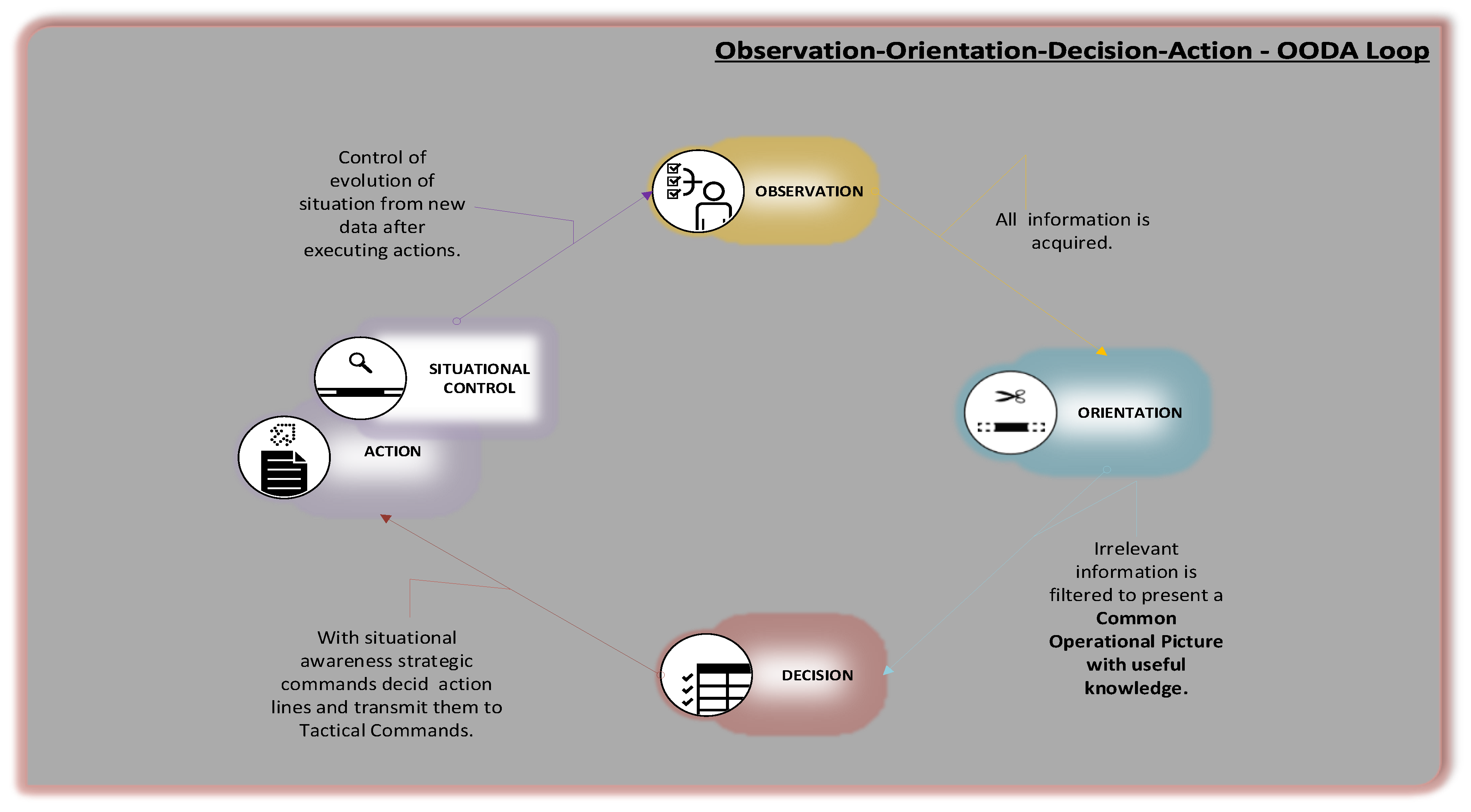
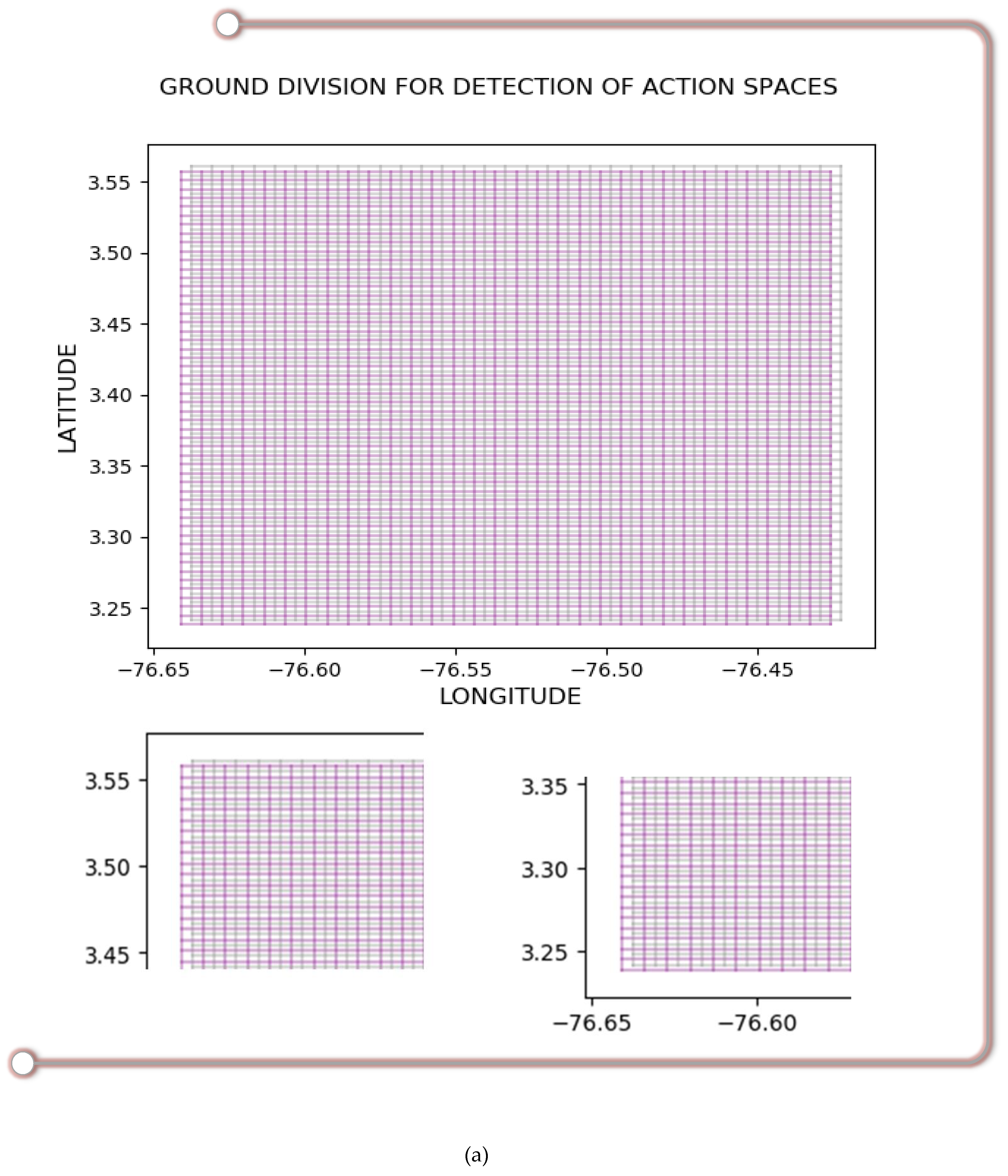
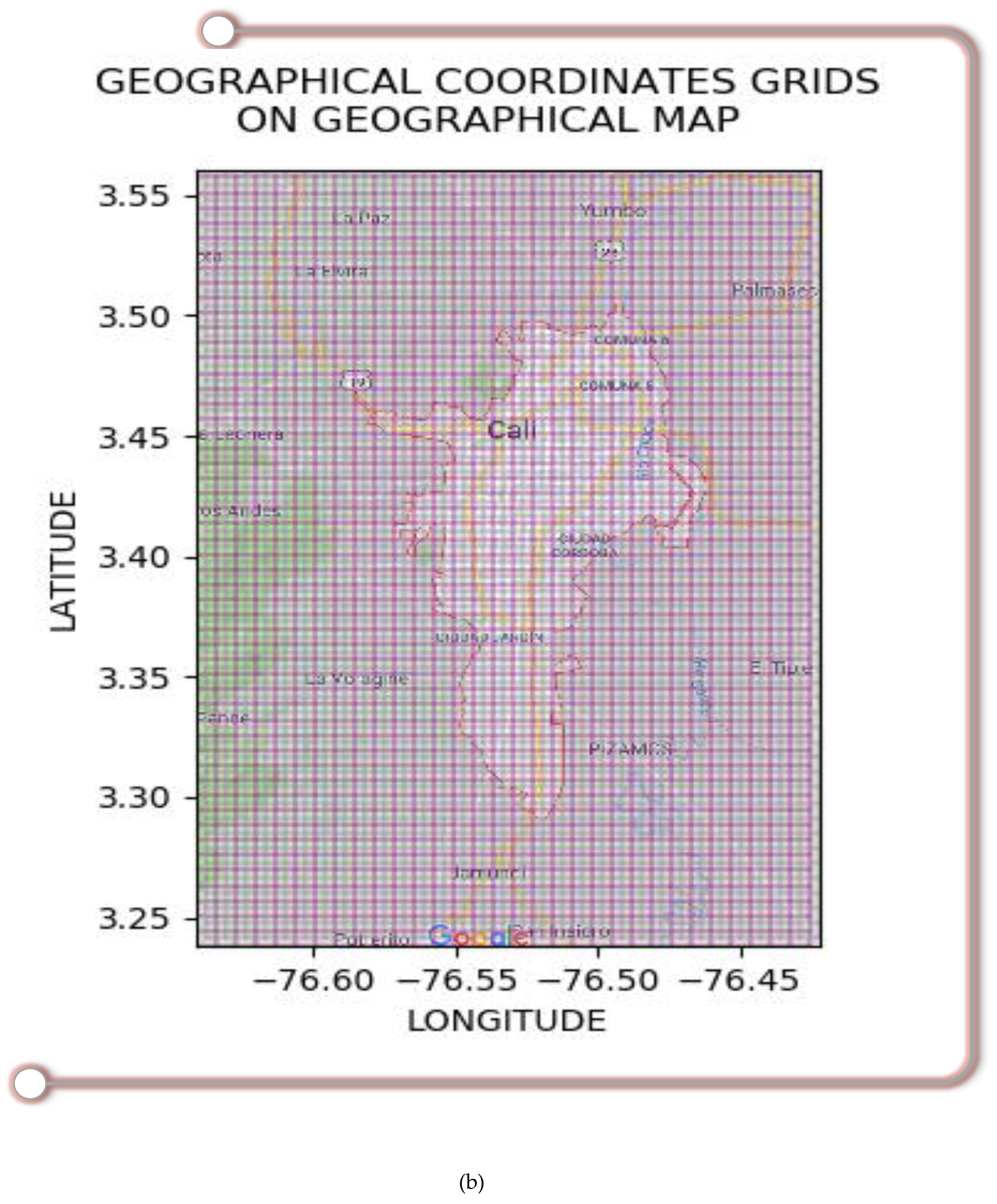
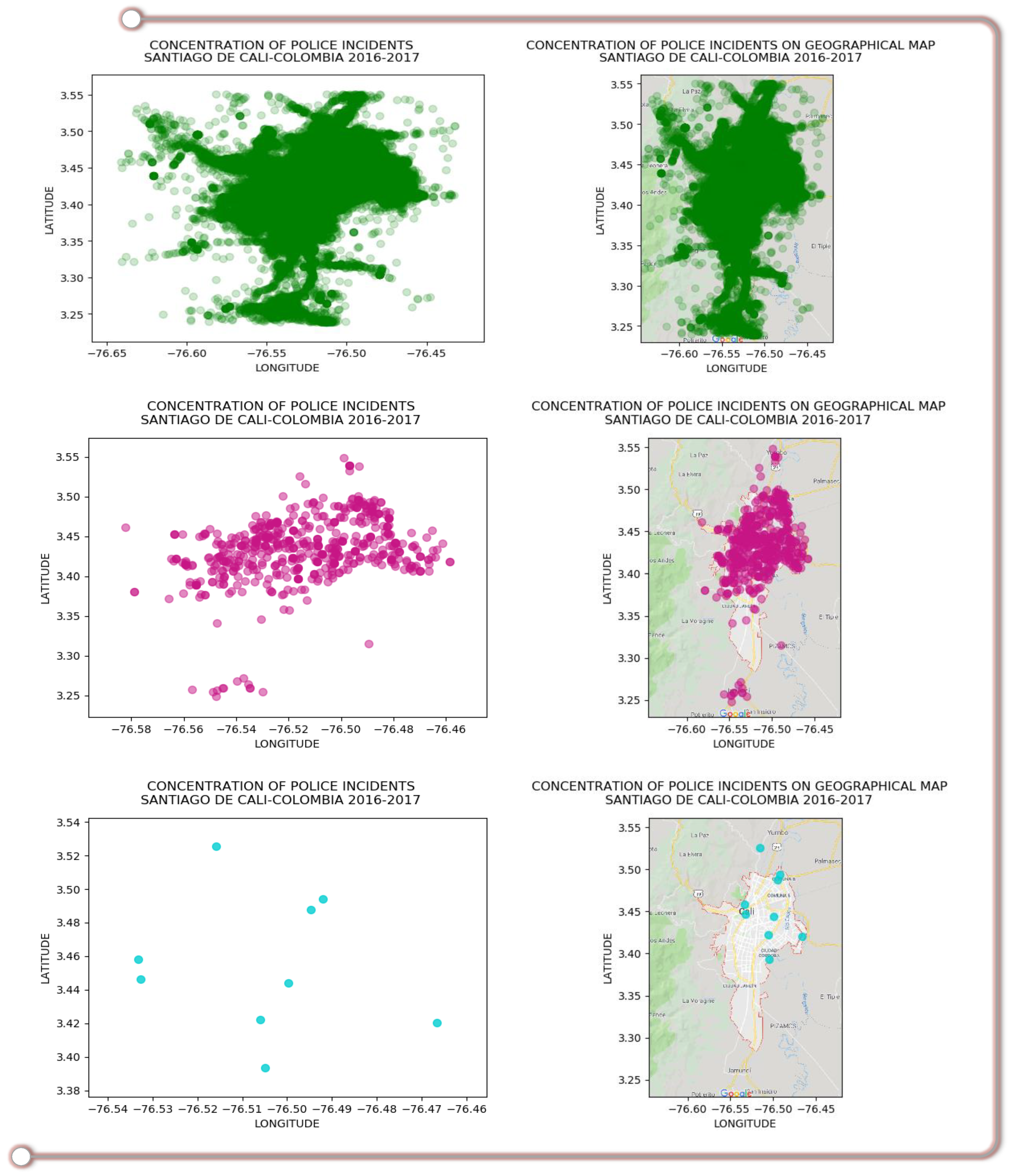
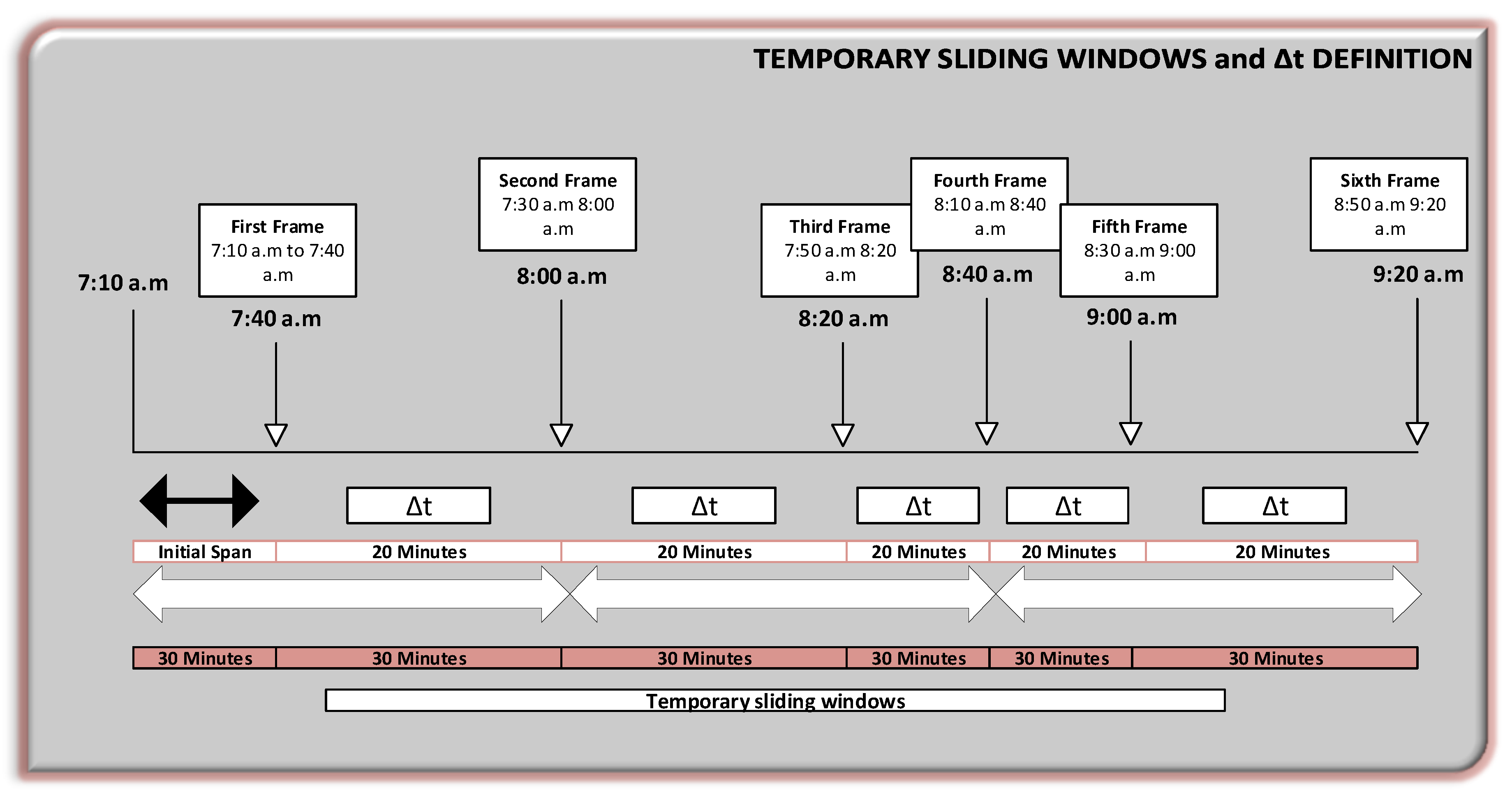
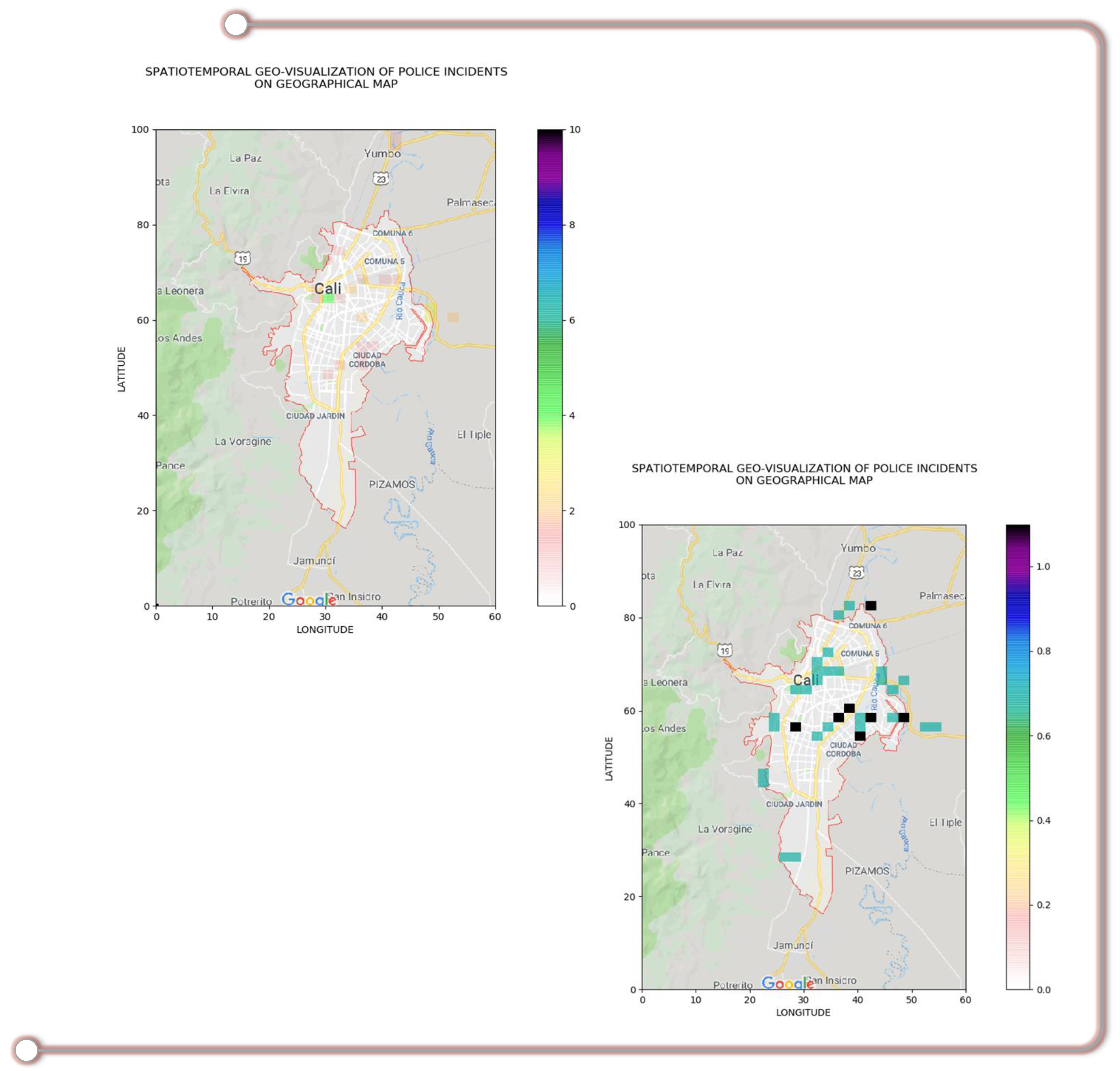
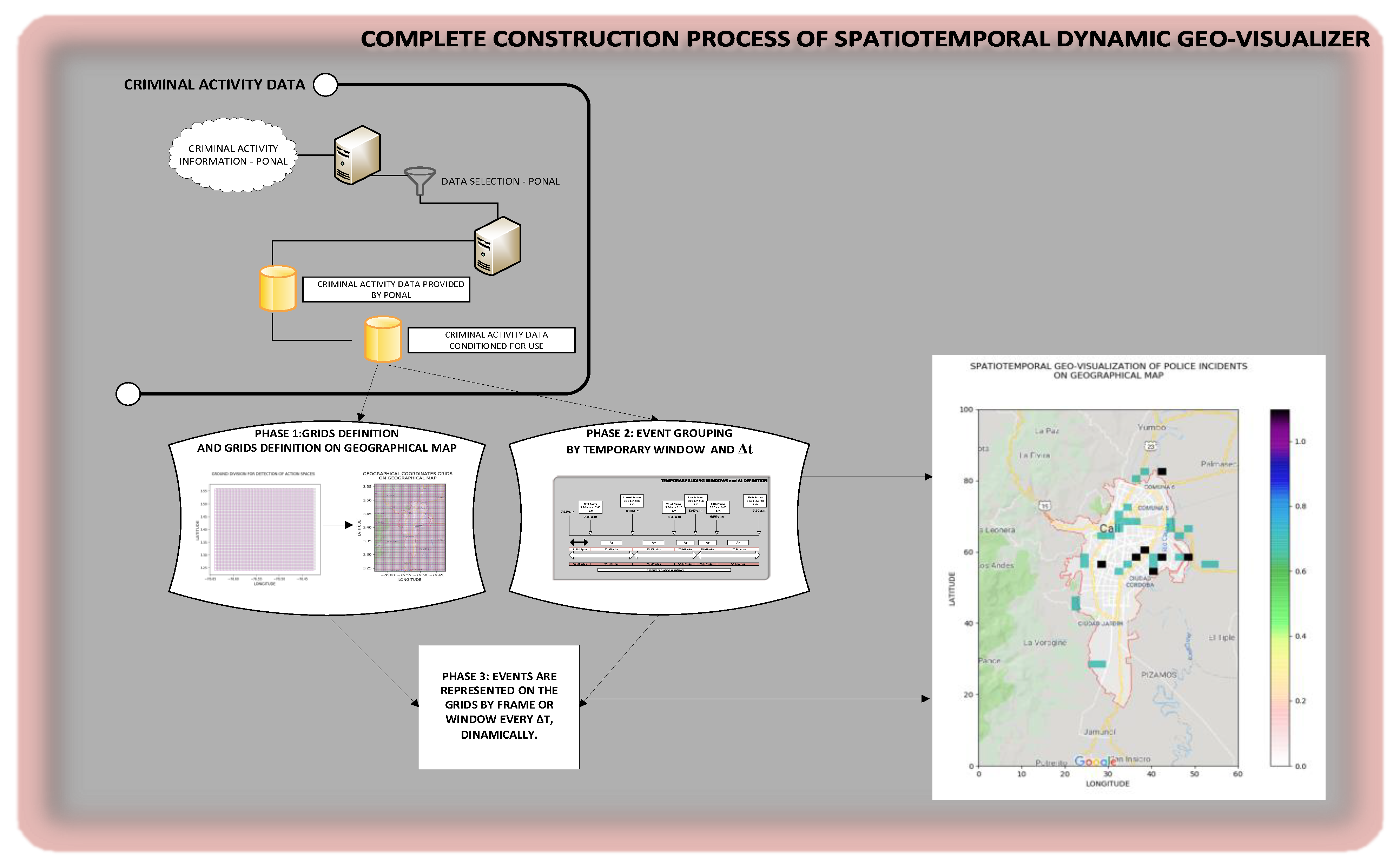

| Crime Geo-Visualization Method | Real-Time Usage | Ease of Use | Spatiotemporal Analysis | Geo-Visualization Flexibility and Adaptability |
|---|---|---|---|---|
| Empirical and observation methods | Very low | Medium | None | High |
| Improvement data visualizations methods | High | High | Very low | Very low |
| Spatial and statistical analysis methods | Low | High | Low | Medium |
| Predictive visualization methods | High | High | High | Low |
| Trajectory analysis methods | Medium | High | Low | Medium |
| Heat maps based on criminal severity | Medium | Medium | High | Medium |
| Open and social media data fusion for temporal analysis and Geo-visualization | High | Medium | Very high | Very low |
| Comparison of criminal similarities through knowledge graph methods | Low | Low | High | Medium |
| Our proposed method | Very high | High | Very high | Very high |
© 2020 by the authors. Licensee MDPI, Basel, Switzerland. This article is an open access article distributed under the terms and conditions of the Creative Commons Attribution (CC BY) license (http://creativecommons.org/licenses/by/4.0/).
Share and Cite
Salcedo-Gonzalez, M.; Suarez-Paez, J.; Esteve, M.; Gómez, J.A.; Palau, C.E. A Novel Method of Spatiotemporal Dynamic Geo-Visualization of Criminal Data, Applied to Command and Control Centers for Public Safety. ISPRS Int. J. Geo-Inf. 2020, 9, 160. https://doi.org/10.3390/ijgi9030160
Salcedo-Gonzalez M, Suarez-Paez J, Esteve M, Gómez JA, Palau CE. A Novel Method of Spatiotemporal Dynamic Geo-Visualization of Criminal Data, Applied to Command and Control Centers for Public Safety. ISPRS International Journal of Geo-Information. 2020; 9(3):160. https://doi.org/10.3390/ijgi9030160
Chicago/Turabian StyleSalcedo-Gonzalez, Mayra, Julio Suarez-Paez, Manuel Esteve, Jon Ander Gómez, and Carlos Enrique Palau. 2020. "A Novel Method of Spatiotemporal Dynamic Geo-Visualization of Criminal Data, Applied to Command and Control Centers for Public Safety" ISPRS International Journal of Geo-Information 9, no. 3: 160. https://doi.org/10.3390/ijgi9030160
APA StyleSalcedo-Gonzalez, M., Suarez-Paez, J., Esteve, M., Gómez, J. A., & Palau, C. E. (2020). A Novel Method of Spatiotemporal Dynamic Geo-Visualization of Criminal Data, Applied to Command and Control Centers for Public Safety. ISPRS International Journal of Geo-Information, 9(3), 160. https://doi.org/10.3390/ijgi9030160






